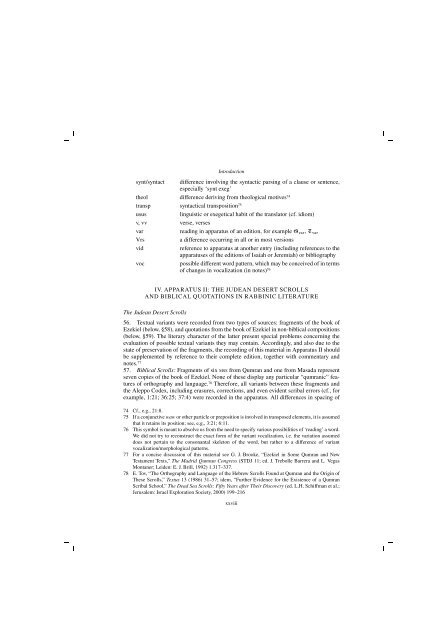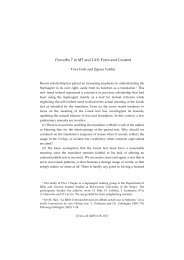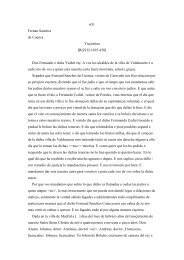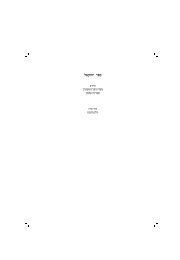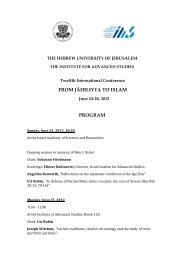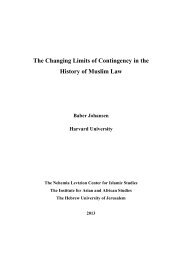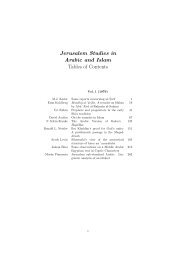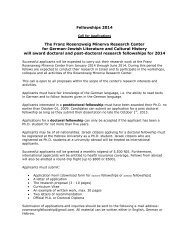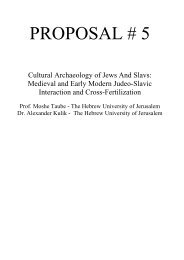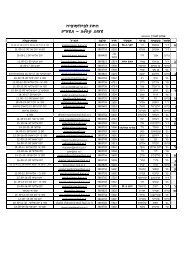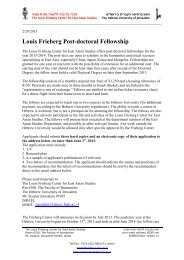THE BOOK OF EZEKIEL Moshe H. Goshen-Gottstein Shemaryahu ...
THE BOOK OF EZEKIEL Moshe H. Goshen-Gottstein Shemaryahu ...
THE BOOK OF EZEKIEL Moshe H. Goshen-Gottstein Shemaryahu ...
Create successful ePaper yourself
Turn your PDF publications into a flip-book with our unique Google optimized e-Paper software.
Introduction<br />
synt/syntact<br />
difference involving the syntactic parsing of a clause or sentence,<br />
especially ‘synt exeg’<br />
theol difference deriving from theological motives 74<br />
transp syntactical transposition 75<br />
usus<br />
linguistic or exegetical habit of the translator (cf. idiom)<br />
v, vv verse, verses<br />
var<br />
reading in apparatus of an edition, for example ]h, Th<br />
Vrs<br />
a difference occurring in all or in most versions<br />
vid<br />
reference to apparatus at another entry (including references to the<br />
apparatuses of the editions of Isaiah or Jeremiah) or bibliography<br />
voc<br />
possible different word pattern, which may be conceived of in terms<br />
of changes in vocalization (in notes) 76<br />
IV. APPARATUS II: <strong>THE</strong> JUDEAN DESERT SCROLLS<br />
AND BIBLICAL QUOTATIONS IN RABBINIC LITERATURE<br />
The Judean Desert Scrolls<br />
56. Textual variants were recorded from two types of sources: fragments of the book of<br />
Ezekiel (below, §58), and quotations from the book of Ezekiel in non-biblical compositions<br />
(below, §59). The literary character of the latter present special problems concerning the<br />
evaluation of possible textual variants they may contain. Accordingly, and also due to the<br />
state of preservation of the fragments, the recording of this material in Apparatus II should<br />
be supplemented by reference to their complete edition, together with commentary and<br />
notes. 77<br />
57. Biblical Scrolls: Fragments of six MSS from Qumran and one from Masada represent<br />
seven copies of the book of Ezekiel. None of these display any particular “qumranic” features<br />
of orthography and language. 78 Therefore, all variants between these fragments and<br />
the Aleppo Codex, including erasures, corrections, and even evident scribal errors (cf., for<br />
example, 1:21; 36:25; 37:4) were recorded in the apparatus. All differences in spacing of<br />
74 Cf., e.g., 21:8.<br />
75 If a conjunctive waw or other particle or preposition is involved in transposed elements, it is assumed<br />
that it retains its position; see, e.g., 3:21; 6:11.<br />
76 This symbol is meant to absolve us from the need to specify various possibilities of ‘reading’ a word.<br />
We did not try to reconstruct the exact form of the variant vocalization, i.e. the variation assumed<br />
does not pertain to the consonantal skeleton of the word, but rather to a difference of variant<br />
vocalization/morphological patterns.<br />
77 For a concise discussion of this material see G. J. Brooke, “Ezekiel in Some Qumran and New<br />
Testament Texts,” The Madrid Qumran Congress (STDJ 11; ed. J. Trebolle Barrera and L. Vegas<br />
Montaner; Leiden: E. J. Brill, 1992) 1.317–337.<br />
78 E. Tov, “The Orthography and Language of the Hebrew Scrolls Found at Qumran and the Origin of<br />
These Scrolls,” Textus 13 (1986) 31–57; idem, “Further Evidence for the Existence of a Qumran<br />
Scribal School,” The Dead Sea Scrolls: Fifty Years after Their Discovery (ed. L.H. Schiffman et al.;<br />
Jerusalem: Israel Exploration Society, 2000) 199–216<br />
xxviii


